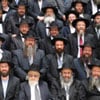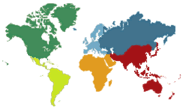If there was a natural theme to this year’s gala banquet that concluded the four-day annual International Conference of Chabad-Lubavitch Emissaries (Kinus Hashluchim), it was related to an inspirational milestone announced 75 years after the Rebbe—Rabbi Menachem M. Schneerson, of righteous memory—and his wife—the Rebbetzin Chaya Mushka, of righteous memory—arrived on U.S. shores from war-torn Europe in 1941.
The big news for the more than 5,600 people celebrating as one at the Pier 8 warehouse in Brooklyn, N.Y.—and for the millions of viewers worldwide who joined by webcast—was the establishment of a Chabad center in South Dakota, to be directed by Rabbi Mendel and Mussie Alperowitz, which means that all 50 states in America, in addition to Puerto Rico and the U.S. Virgin Islands, will have a permanent Chabad presence. The center will be situated in Sioux Falls, the largest city in the state.
“He’s going out to the last state without a shaliach,” notes Rabbi Michoel Goldman, who co-directs Chabad Kauai in Princeville, Hawaii, with his wife, Zisel. “It brings us to a certain level of completion in the United States.”
The number 50 in Torah is very powerful, he adds, explaining that it’s a number he focuses on in his work, as Hawaii was the 50th state of the nation. “After 49, there are a few examples in the Torah where the number 50 is like the cherry on top. Forty-nine days for the Omer; on the 50th, we got the Torah, the Divine bestowing of the biggest gift. Forty-nine years of counting, and the 50th is the jubilee.”
Rabbis hailing from 90 countries and their guests applauded the new development, which was pronounced by Rabbi Moshe Kotlarsky, vice chairman of Merkos L’Inyonei Chinuch, the educational arm of the Chabad-Lubavitch movement, and director of the Kinus. It followed an introduction by Rabbi Yehuda Krinsky, chairman of Merkos L’Inyonei Chinuch.
“The Rebbe wanted to make real the saying, ‘No Jew should be left behind.’ For that purpose, he had to reach each and every Jew, no matter where they are in the globe,” said Krinsky. “He was able and succeeded in inspiring young men and women to take that task upon themselves—a task that is 24/7; it never ceases. When you eat, when you sleep, you are a shaliach. You dream shlichus, you discuss shlichus, you live with it, and this is your life.”
The first Kinus took place in 1983 (33 years ago) in a conference room at Lubavitch World Headquarters at 770 Eastern Parkway in the Crown Heights neighborhood of Brooklyn, attended by 55 shluchim. That number was multiplied 100 times over this year.

‘A Breath of Fresh Air’
One of the newcomers was Rabbi Ari Rubin, from Cairns, Australia, where the nearest Jewish community is a three-hour flight away. Rubin moved there from Melbourne earlier this year with his wife, Mushkie, and young daughter, Devorah Leah. He says he was thrilled to find strength, spirituality, community and camaraderie during every aspect of the conference. He even announced his first-time status with exuberance as part of a video portraying emissaries around the world, noting how many annual conferences they have attended.
“Coming here is really a huge breath of fresh air for me, and I have been looking forward to it for months,” says Rubin of the long weekend, which included speakers, workshops, and a visit to the Ohel in Queens, N.Y.—the Rebbe’s resting place. “I have taken many workshops here, and can’t wait to use the tips and advice, which I got plenty of.”

Coming from a small community of around 500 Jews (with another 500 in the vicinity), he runs Chabad of RARA based in Northern Queensland, where they barely got a minyan (a prayer quorum of 10 Jewish men) together on Simchat Torah. At the Kinus, he said: “Thousands of rabbis who might also have had a tiny minyan get to dance together—the biggest dance we could imagine.”
Goldman, of Hawaii, attended the Kinus last year after a three-year gap and said he was glad to return again. He arrived in New York on Thursday morning and heads back to the Aloha State on Monday. Goldman said the video clips of the Rebbe, which were shown on a series of screens around the banquet room between speakers, were powerful, as was the dancing at the end of the event, when men abandoned their tables and circled the room in song.
“The unity and the brotherliness and the oneness of the family of shluchim and Chassidim at the very end . . . it’s beyond all boundaries,” he described. “For me, it’s about going back recharged, and having a tremendous uplifting of spirit and optimism. I also picked up some tools and tips in the sessions, but above all, it’s about reconnecting and realigning ourselves with our mission, and then going back much more in touch.”
He noted that he used the messaging tool WhatsApp to send his community links to watch the proceedings live: “Some were watching in Hawaii and even texting me while I was at the banquet.”

‘A G‑dly Home’
Tehillim were recited by Rabbi Avrohom Korf, head shaliach to the state of Florida, who was sent to the Sunshine State by the Rebbe in 1960, a time when Jews were restricted from living in certain towns and apartment buildings. His lone presence 56 years ago has blossomed into 219 Chabad emissaries and 200 Chabad centers statewide.
The keynote address was given by Malcolm Hoenlein, executive vice chairman of the Conference of Presidents of Major American Jewish Organizations, who gave a rousing talk, emphasizing his longtime ties to Chabad and his appreciation for their mission.
“I always felt that you could light all of Brooklyn . . . and maybe even New York City, with the electric energy generated each year here,” he said, in what he noted was going to be a “politics-free” talk. “It’s not impossible because Chabad has been lighting the world for many years.”
Focusing on the positive, proactive growth that is the hallmark of Chabad-Lubavitch, uniting Jewry everywhere around the globe, Hoenlein delighted the audience when he quipped: “I am convinced that in Chabad schools they only teach addition and multiplication—not division and subtraction.”

The Theme of Connection and Faith
The theme of the this year’s Kinus—of connection and faith—was discussed by Rabbi Dovid Yitzchok Hazdan, dean of the Torah Academy and rabbi of the Great Park Synagogue in Johannesburg, South Africa. He offered a brief history of Jewish change in South Africa, offlight and stagnation. But this was also timed with a spiritual awakening and the establishment of Chabad centers in the country’s cities.
“Chabad would change the face of Jewish life in South Africa,” he said, noting the current pulse of the nation, including his own community’s building of a new mikvah that serves 100 families.
Addressing the shluchim, he said: “We need to preserve and develop our commitment to the tower that anchors our bridges that we are building. It is by holding on to the teachings of our Rebbe, the directives of the Rebbe, that we have a capacity to influence and affect positive change, and to make this world a G‑dly home.”
“It is only if we are connected to something higher that we do not slip here below,” he added, alluding to the story of Reb Meir of Premishlan. He then went on to praise the tireless work of the wives, mothers, daughters and grandmothers, without which the men could not succeed.

‘A Very Special Atmosphere’
Rabbi Herschel Finman, of Lubavitch Foundation of Michigan, noted that even though the conference has grown exponentially over the decades, it has consistently been able to provide him with fresh and valuable information to address the changing needs of those he serves.
These days, he works with young adults and singles primarily in the fast-growing areas outside of Detroit. “I do a lot of mentoring, and I do a lot of listening,” he said. “And good ideas are coming from younger people who have a lot of energy and a lot of enthusiasm.”
And, he added, ideas come from the Kinus as well. He said rabbis of all ages have much to learn from each other over the course of the four-day program.
Rabbi Lev Cotlar, of the Chabad Center of Raleigh, N.C., spent the Kinus honing skills and recharging his spiritual batteries. “It’s just a very special atmosphere, with groups of people from all walks of life and nationalities with one purpose,” he said.
His wife, Dassy, is home with their three children—ages 2, 4, and 6—while he stocks up on tips to bring home to their community, which includes visits to Jewish inmates at a federal prison. He said the gathering fills him with awe: “No one could have imagined the scope of where shluchim are and how it has impacted the world.”

‘A World of Kindness and Goodness’
That impact is not just felt in the United States, even though that was a focus of this year’s banquet. Kotlarsky also noted the presence of Ambassador Danny Danon, Israel’s Permanent Representative to the United Nations, and Dani Dayan, the Israeli counsel general of New York, wishing the Israeli people safety and security.
He also talked of Russia, and the great progress that’s been made in the 25 years since the dissolution of the Soviet Union on Dec. 26, 1991. “You have to see the contrast to believe this. When we were there 25 years ago, there were four shluchim in the former Soviet Union, which was then the Soviet Union. Today, there are 362 shluchim in the former Soviet Union. Where there were four Chabad Houses, today there are 287. Where there were six schools, today there are 132. Where there were 140 students, today there are 14,720 students learning in Russia, and in Ukraine, and in Azerbaijan and in Uzbekistan, and throughout the length and breadth of the Soviet Union.
“And this is not only the Soviet Union. You saw the growth of how many shluchim there were in Europe then. At that period in time, there were about 120. Today, there are over 790 shluchim in Europe.”
As Kotlarsky summed up: “They go out in the world for one reason—to fulfill the mission that the Rebbe entrusted us with, to make this world a world of goodness and kindness. To better this world, to bring Torah and mitzvahs to each and every Jew.”













Start a Discussion